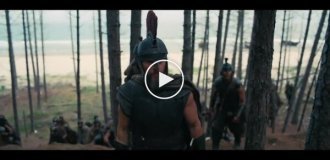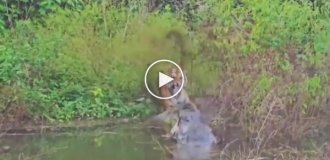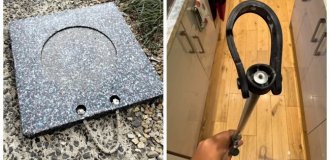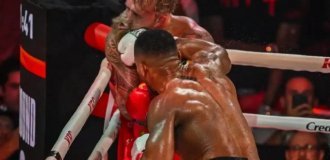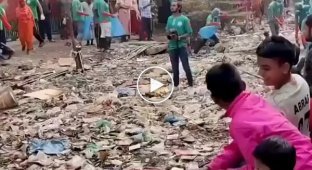Daskalio - the oldest Aegean "palace" with running water 1000 years before the Minoans (9 photos)
The Bronze Age in Greece is the Trojan War. Bronze Age - these are the warlike Mycenaeans and their majestic cyclopean strongholds from giant stone blocks. The Mycenaeans are an ancient antiquity. However, the Mycenaeans perceived the same old Minoan neighbors from the island Crete. But that's not all. 
The Minoans inherited the achievements and maritime trade routes of the first Aegean civilization in the Cyclades. And today our story about Daskalio on the island of Keros - an amazing place of this ancient and mysterious culture. 
Settlements in the Cyclades were founded during the Neolithic period, around 5000 BC, and in the early Bronze Age the Cycladians began grow olives and grapes in addition to barley and wheat. AT many people lived in settlements, and evidence of the existence of seals (as in Crete and the mainland) indicate some form of administrative systems.
In the early Bronze Age, the Cyclades were engaged in a profitable business. production of objects from obsidian, unique marble figurines, bronze weapons and tools, jewelry made of local copper and silver.
Building on advances in shipbuilding, island communities established trade links with the mainland, Anatolia and Crete. For your time, the Cycladians created an advanced culture and a center of civilization in region.
One of the most important places of the Cycladic culture was the island Keros. Here at Cape Kavos, 733 marble sculptures in the form of stylized human figures. There were 2400 fragments of marble bowls and vessels. These things intentionally broken on the islands of origin and then brought to Keros. 
Fragments of broken Cycladic idols from the island of Keros.
Further archaeological excavations on the island forced pay attention to another interesting place - Dascalio. it a tiny island formed as a result of rising sea levels. AT ancient times, 4500 years ago it was connected by a narrow dam with Keros.
Recently, archaeologists have unearthed the terraces of Dascalio, where under the surface hidden achievements of engineering, able to compete with impressive building appearance. Evidence found first complex of drainage tunnels built 1000 years before the famous internal plumbing of the Minoan palace at Knossos, Crete. 
Gutter under the marble steps on Dascalio. The steps break off at the ancient water level in the sea.
The researchers then discovered two workshops full of evidence of metalworking, and objects, including lead (!) an ax and molds for casting daggers and spearheads. Secrets of the Ancients technologies became clear after examining an intact clay oven for melting. It is worth noting that at the dawn of the age of metal, its processing was considered more of a magic, a sacred act, than a craft. Access to both skills, and limited to raw materials.
Probably, the workshops are connected with the smelting of local copper ores. Also, raw copper ore was brought from Serifos or Sifnos. On the covered with forests of Kerose, they took wood for living into coal. 
Stone mold for casting copper and bronze spearheads from Dascalio Island.
Also found in the soil are traces of legumes, grapes, olives, figs and almonds, as well as wheat and barley. Then the foundations were opened pantries and numerous fragments of ceramic vessels for storage food. Sheep and goat bones were found. There were few fish and shells. Based amount of fertile land on the island of Keros, it became clear that these products were brought from somewhere.
Analysis of the pottery showed that it is from the neighboring islands of Koufonisi, Naxos, Amorgos and Ios. Some vessels came from Melos and Thera, Syros and Sifnos. There are clear signs of the presence of ceramics (a characteristic shape in gravy boat) from mainland Greece. It's amazing that it wasn't fragments of cult sculptures with folded hands, so often found in the “idol vaults” on Kavos. 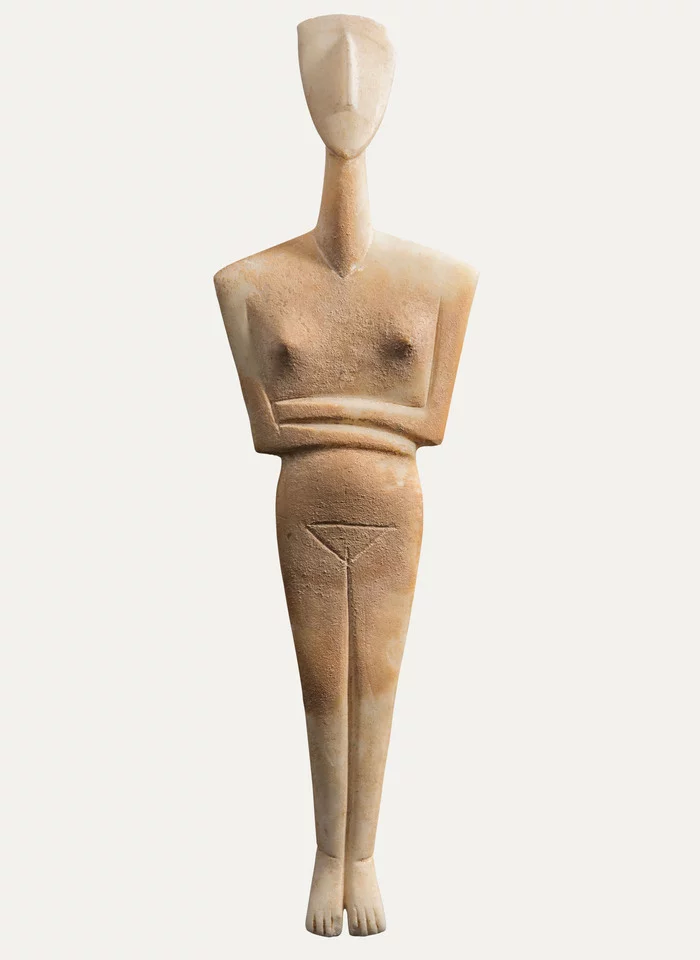
A typical "idol" figurine from the Museum of Cycladic Art in Athens.
Excavations have clearly shown that this was not a burial site. dead, although some graves were located next to the vaults of the broken idols at the neighboring Cape Kavos.
Having collected a lot of materials, experts on ancient architecture. They concluded that more than 4,000 years ago, the ancient builders terraces were carved on the surface of a natural cape of a pyramidal shape. Then, in an unknown way (probably on rafts), they brought about 1000 tons marble. The stone was not local. The most likely source for southeast coast of the island of Naxos, which is 10 kilometers from Daskalio.
Brought marble became a building material for buildings for various purposes. After completion of the work, the complex began to look like like a gigantic stepped pyramid of gleaming white stone. Undoubtedly, it was the most imposing man-made structure on throughout the archipelago and the shores of the Aegean at that time. 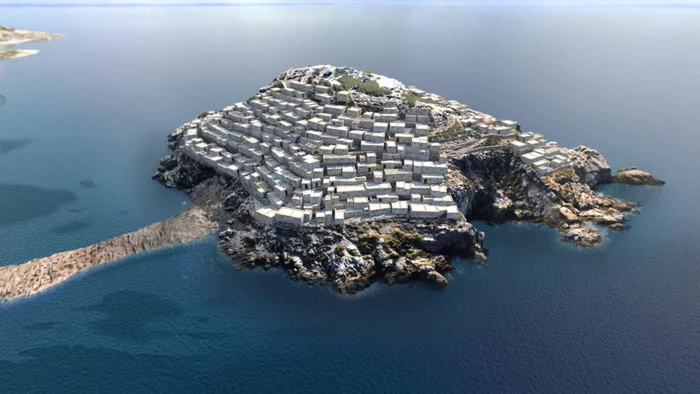
Three-dimensional historical reconstruction of the appearance of the complex of buildings on the island of Daskalio in the early Bronze Age.
In the early Bronze Age, the Dascalio complex connected with Kavos on Keros by a natural dam. It provided shelter from the weather. for ships.
Radiocarbon analysis and dating of layers on ceramics indicate that people used this place from about 2750 to 2300 BC ad.
So, we have collected some facts about an incomprehensible complex of buildings Cape Daskalio on the Cycladic island of Keros. By bringing them together, you can go back in time 5000 years and try to look at it place in the Early Bronze Age.
The communities of the Cyclades interacted with each other. At with the help of long boats, they established among themselves cultural, religious and economic ties. On some islands, copper, lead, silver and gold to burn trees on other islands to smelt ore into implements, weapons and ornaments. The Cycladians also worked with obsidian and marble of local origin. Then these things and resources were transported to Anatolia (Troy I, Troy II), Greece and Crete (in these places Cycladic artifacts discovered).
Most likely, the islanders took food in return. These products helped support the complex structures associated with shipbuilding, navigation, manufacturing and trade in weapons. Cycladic people became the most advanced and prosperous society cultural and historical region of the Aegean on the islands and shores of the Aegean and Cretan Sea. 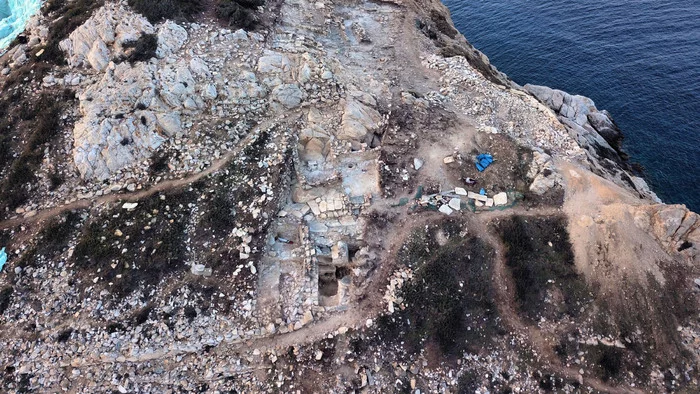
Photo from the excavation site on the islet of Dascalio.
Together with material values, ideas and symbols (for example, the famous spiral ornament). We see that the Hellads, Anatolians and Cretans imitated Cycladic idols and utensils and almost probably borrowed some of the religious concepts.
Mutually beneficial ties brought Cycladic communities from different islands closer together so much so that a common center was needed. The place for such a center was chosen in the most convenient harbor at Cape Dascalio. Gradually, generation after generation brought here building material for buildings, products for staff of the pyramid complex and visitors from other islands and shores of the Aegean. According to the size of the settlement and stocks, you can assume that the resident population was no more than twenty people, and temporary - up to 400 people.
The maintenance, as well as the construction of the settlement, required significant public effort. Dascalio could not be self-sufficient, after all, most of the food, building materials and ore for metal processing had to be brought in from outside.
What united people and gave motivation to spend colossal resources? Religion of course! The key to understanding the purpose of Dascalio was vaults at the nearby Cape Kavos. Precisely two vaults for the broken idols and cult bowls were the very place where people flocked from distant lands (then the journey from Greece to Crete took several days). That is why during the excavations of the pyramidal complex was not found fragments of sculptures with folded hands, so often found on Kavose.
This is because archaeologists have unearthed an inn for pilgrims.
This does not negate the more complex purpose of this place as a center production of high-tech and at the same time mystical copper and bronze weapons. This does not prevent some religious events from being held here. ceremonies, as will be later with subsequent Minoan "palaces" without kings, but this is an auxiliary object in relation to the “tombs” broken idols. 
Remains of large clay vessels for storing grain, wine or oil. Excavations of the Dascalio building complex.
People from the Cyclades periodically came to Keros and, possibly also from mainland Greece. They did it yearly or every fouryat years. The settlement on Dascalio was the place where stayed during these visits for one or more nights. If a we conclude that the visits had a symbolic purpose, we can call this place is a "sanctuary", that is, a place for periodic ritual visits. In addition, it was the first regional sanctuary in the Aegean sea where pilgrims come.
It seems that we have solved all the riddles of Kavos and Dascalio, except one. It remains to understand why the broken idols were “buried” here?
Perhaps there is an answer to this question. While studying some surviving Cycladic figurines, it becomes clear that they were originally painted. They were painted with multi-colored symbols and patterns. It is believed that such signs had a sacred meaning. Every year to some event (religious festival?) they were repainted, and then used for ritual purposes (perhaps in processions).
When some obscure term of use came to an end, ritual objects could not be thrown away. They should have been removed from sacred address. The figurine was deliberately split, depriving the magic strength. But this was not enough and it was necessary to take part of the broken a sacred object to Keros in order to “bury” it.
The assumption of scientists makes one wonder where the the rest of the parts. Confirmation of this hypothesis would be the discovery next to one or more ancient Cycladic ruin settlements broken figurines resulting from ritual murder religious symbol. However, this has not yet happened.
